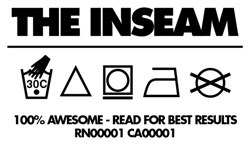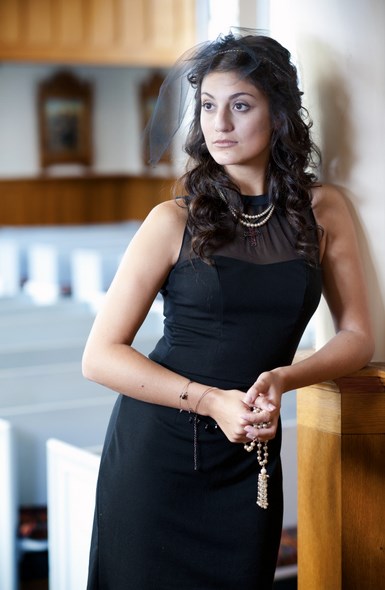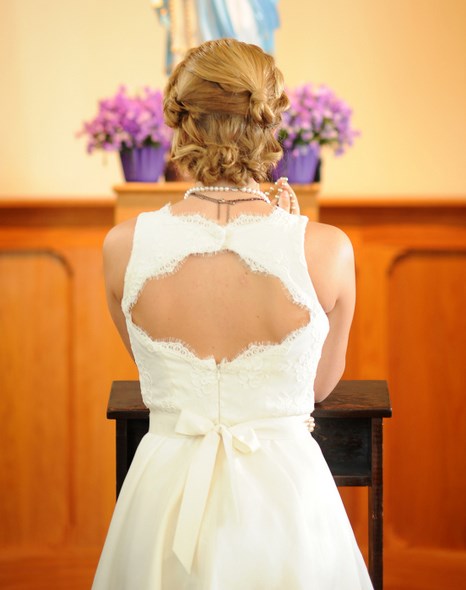 |
Vancouver is home to a thriving fashion industry made up of individuals committed to its growth and success. Get to know these personalities in The Inseam and discover what makes the Vancouver Fashion scene so awesome. Every month, The Inseam’s Eco Edition focuses on the innovators that shape the green movement in local fashion. |
 Photo courtesy of Pure Magnolia
Photo courtesy of Pure Magnolia
Pure Magnolia is fantastic example of a designer who is creating pieces that you would never guess are “eco”, in perhaps the most difficult market: made-to-order, couture bridal. They are helping dispel the myths that still exist around ecofashion, such as green brides wear hemp and Birkenstocks.
Patty Nayel started sewing in high school on her grandmother’s old sewing machine, carrying on her ‘hobby’ of making clothes into university. But when she realised that instead of studying for exams in her physics and chemistry program she was sneaking into her sewing room, she switched gears and entered the fashion design program at Kwantlen University to take on fashion as a career.
Jessica McIlroy: Tell me how you got started in bridal.
Patty Nayel: I never really wanted to open my own business, but my final collection at school was eco-friendly wedding dresses, and a couple people bought dresses from that. At the same time I was a technical designer and pattern maker with a high end lingerie company, and I started making some dresses on the side because people would ask for them. I had a small website from my final year and kept doing little promotions and wedding fairs, and it got to the point where I needed to commit to it full time and quit my job.
JM: Why did you choose bridal for your final collection?
PN: We had to pick an underserviced niche market. It was very hard to figure out something that was marketable, would look good in a portfolio, was something I was interested in, and fit the profile as described by our teachers. I was working at the lingerie manufacturers and discovered that there was a lot of waste fabric. They would make beautiful high end chemises, cut on the bias, leaving huge corners that would sometimes get sold off as scrap but often just thrown away. So I was trying to figure out ways to use all of that and recycle it. I didn’t want to do lingerie, and bridal was the next best piece of the puzzle.
JM: It would be a lot of the same fabrics I assume.
PN: Yeah, a lot of similar fabrics, the silks and lace, and things like that. So I started to do more research on eco bridal and realised there wasn’t much out there. Especially that looks like mainstream bridal. I wanted to design a collection that was different than dresses that you’d find in mainstream stores, and make it a bit more couture. I wanted to set myself apart from the competition, but be mainstream enough that brides could find what they wanted. And it really worked.
JM: Showing how people choose clothes not really because they are eco-friendly, but really because of the designs.
PN: Yes, a lot of people would love an eco-friendly dress, but if they find their ideal dress, it doesn’t matter as much.
 Photo courtesy of Pure Magnolia
Photo courtesy of Pure Magnolia
JM: Yes, and you’ll find that with everyday clothing so I can only imagine how much more so when it comes to bridal gowns.
PN: Now I have a lot of variety so I can cover everything and do a lot of different options. Getting them the dresses they want, and still being eco-friendly.
JM: So you started by focusing on the eco-friendly aspect related to waste, have you incorporated other areas such as sourcing?
PN: Definitely. You have to source big amounts from suppliers, so at first we were using a lot of vintage and recycled fabrics. Our organic cotton comes from the States, and we bring in a lot of silks from smaller villages in Northern India. But we need to have a certain level of consistency, which is hard when you are doing sustainable fabrics. Buying a fabric from a small village is great, but next year they might not make it. So we need to balance the consistency with the sustainability.
JM: So I guess it comes down to needing to have a lot of different sources.
PN: Definitely, almost all of our fabrics come from a different place.
JM: You’ve been able to find all the fabrics you need for bridal designs?
PN: Yes. All the laces come from Europe, on old machines, through traditional practices. Always natural fibres if we can’t get organic. We do our best.
JM: Of course, you do the best you can at all stages of the processes.
PN: The fabric is only a small part of it. The manufacturing process is very important and we are making all the dresses here, and made to order so there isn’t excess production that is thrown away or sold off in a massive sale. A bride comes in, tries on a sample, orders it and we make the dress for her. It takes a little more time, but it’s totally worth it to not have that extra waste.
JM: So you still very much focus on having as little waste as possible?
PN: We use a lot of the excess little pieces, and when I cut out a dress, we save all the scraps because another dress might have a need for smaller pieces. Eventually we are just down to shreds, and some of those we shred up and use in a technique called silk fusion, which is similar to felting. But that takes a lot of effort. We have done a lot of accessories that use a lot of scraps and people have contacted us for scraps. We actually just threw away our first bag of fabric scraps about two months ago and it was just a shopping bag size, after two years.
JM: Fantastic! That’s something to be proud of.
Know someone looking for a couture and eco-friendly bridal gown or bridesmaids dresses? You can find Pure Magnolia online, on facebook, and by emailing Patty Nayel.


